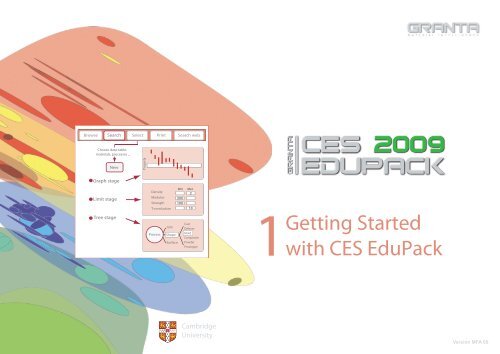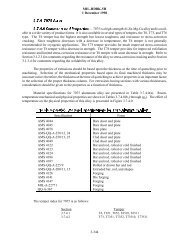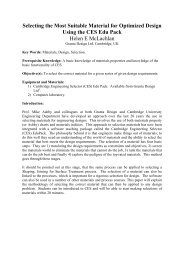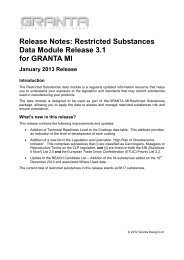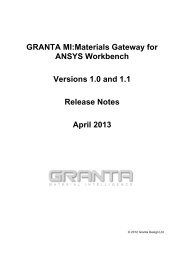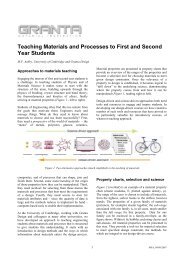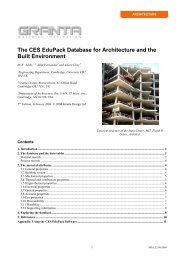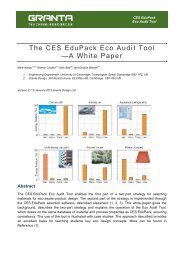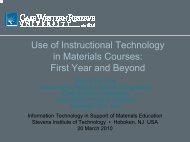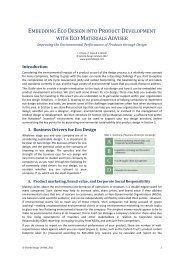Getting Started with CES EduPack - Granta Design
Getting Started with CES EduPack - Granta Design
Getting Started with CES EduPack - Granta Design
Create successful ePaper yourself
Turn your PDF publications into a flip-book with our unique Google optimized e-Paper software.
Browse Search Select Print Search webChoose data-table:materials, processes ...NewProperty●Graph stage● Limit stage● Tree stageDensityModulusStrengthT-conductionProcessJoinShapeSurfaceMin Max220010010CastDeformMoldCompositePowderPrototype<strong>Getting</strong> <strong>Started</strong>1<strong>with</strong> <strong>CES</strong> <strong>EduPack</strong>CambridgeUniversityVersion MFA 09
<strong>Getting</strong> started <strong>with</strong> <strong>CES</strong> <strong>EduPack</strong>These exercises give an easy way to learn to use the <strong>CES</strong> <strong>EduPack</strong> software.The comprehensive <strong>CES</strong> Help file <strong>with</strong>in the software gives more detailed guidance.Thumbnail sketch of <strong>CES</strong> <strong>EduPack</strong>The <strong>CES</strong> <strong>EduPack</strong> software has three Levels of Database.CoverageContentLevel 1 Around 70 of the most widely used materialsdrawn from the classes: metals, polymers,ceramics, composites, foams, and naturalmaterials.Around 70 of the most widely used processes.Level 2 Around 100 of the most widely usedmaterials.Around 110 of the most commonly usedprocesses.Level 3 The core database contains more than 3,000materials, including those in Levels 1 and 2.Specialist editions covering aerospace,polymers, architecture, bio-materials, and ecodesignare also available.When the software opens you are asked to choose a Level. Chose Level 1 to start <strong>with</strong>.A description, an image of the material in a familiarproduct, typical applications, and limited data formechanical, thermal, and electrical properties, usingrankings where appropriate.All the content of Level 1, supplemented by moreextensive numerical data, design guidelines,ecological properties, and technical notes.Extensive numerical data for all materials, allowingthe full power of the <strong>CES</strong> selection system to bedeployed.At each Level there are a number of Data Tables.The most important are: Materials, Shaping Processes, Joining Processes, and Surface Treatment.Each of the three levels can be interrogated by• BROWSING Exploring the database and retrieving records via a hierarchical index.• SEARCHING Finding information via a full-text search of records.• SELECTION Use of powerful selection engine to find records that meet an array of design criteria.<strong>CES</strong> <strong>EduPack</strong> does far more than this. But this is enough to get started.© <strong>Granta</strong> <strong>Design</strong>, January 2009 1
BROWSING and SEARCHINGThe DEFAULT on loading <strong>CES</strong> <strong>EduPack</strong> Levels 1 & 2 is LEVEL 1, MATERIALS UNIVERSEFile Edit View Select Tools WindowExercise 1 BROWSE materialsBrowseSearchSelect• Find record for STAINLESS STEEL• Find record for CONCRETETable:Subset:MaterialUniverseEdu Level 1• Find record for POLYPROPYLENE• Explore POLYPROPYLENE record at LEVEL 2• Find PRO<strong>CES</strong>SES that can shape POLYPROPYLENEusing the LINK at the bottom of the recordMaterialUniverse++++Ceramics and glassesHybrids: composites etcMetals and alloysPolymers and elastomersExercise 2 BROWSE processesSelect LEVEL 2, ALL PRO<strong>CES</strong>SES• Find record for INJECTION MOLDINGFile Edit View Select Tools WindowBrowseSearchSelect• Find record for LASER SURFACE HARDENING• Find record for FRICTION WELDING (METALS)Table:ProcessUniverse• Find MATERIALS that can be DIE CAST ,using the LINK at the bottom of the record for DIE CASTINGSubset:Edu Level 2ProcessUniverseBrowseSearchSelectExercise 3 The SEARCH facility• Find the material POLYLACTIDE+++JoiningShapingSurface treatmentFind what:Look in table:PolylactideMaterialUniverse• Find materials for CUTTING TOOLS• Find the process RTM(Part of a material record and a process record are shown overleaf)© <strong>Granta</strong> <strong>Design</strong>, January 2009 2
Part of a record for a material: polypropylenePolypropylene (PP) (CH2-CH(CH3))nPolypropylene, PP, first produced commercially in 1958, is theyounger brother of polyethylene - a very similar molecule <strong>with</strong>similar price, processing methods and application. Like PE itis produced in very large quantities (more than 30 million tonsper year in 2000), growing at nearly 10% per year, and like PEits molecule-lengths and side-branches can be tailored byclever catalysis, giving precise control of impact strength, andof the properties that influence molding and drawing. In itspure form polypropylene is flammable and degrades insunlight. Fire retardants make it slow to burn and stabilizersgive it extreme stability, both to UV radiation and to fresh andsalt water and most aqueous solutions.General propertiesDensity 0.89 - 0.91 Mg/m 3Price1.102 - 1.61 USD/kgMechanical propertiesYoung's Modulus 0.896 - 1.55 GPaShear Modulus 0.31 - 0.54 GPaBulk modulus 2.5 - 2.6 GPaPoisson's Ratio 0.40 - 0.42Hardness - Vickers 6.2 - 11.2 HVElastic Limit 20.7 - 37.2 MPaTensile Strength 27.6 - 41.4 MPaCompressive Strength 25.1 - 55.2 MPaElongation 100 - 600 %Endurance Limit 11.0 - 16.5 MPaFracture Toughness 3 - 4.5 MPa.m 1/2Loss Coefficient 0.025 - 0.044Thermal propertiesThermal conductor or insulator? Good insulatorThermal Conductivity 0.113 - 0.167 W/m.KThermal Expansion 122.4 - 180 µstrain/KSpecific Heat 1870 - 1956 J/kg.KMelting Point 149.9 - 174.9 °CGlass Temperature -25.15 - -15.15 °CMaximum Service Temperature 82.85 - 106.9 °CMinimum Service Temperature -123.2 - -73.15 °CElectrical propertiesElectrical conductor or insulator? Good insulatorResistivity 3.3e22 - 3e23 µohm.cmDielectric Constant 2.2 - 2.3Power Factor 5e-4 - 7e-4Breakdown Potential 22.7 - 24.6 1000000*V /m<strong>Design</strong> guidelinesStandard grade PP is inexpensive, light and ductile but it has low strength. It is more rigid than PEand can be used at higher temperatures. The properties of PP are similar to those of HDPE but it Reis stiffer and melts at a higher temperature (165 - 170 C). Stiffness and strength can be improvedfurther by reinforcing <strong>with</strong> glass, chalk or talc.When drawn to fiber PP has exceptional strength andresilience; this, together <strong>with</strong> its resistance to water, makes it attractive for ropes and fabric. It ismore easily molded than PE, has good transparency and can accept a wider, more vivid range ofcolors. PP is commonly produced as sheet, moldings fibers or it can be foamed. Advances in catalysis promisenew co-polymers of PP <strong>with</strong> more attractive combinations of toughness, stability and ease of processing. Monofilamentsfibers have high abrasion resistance and are almost twice as strong as PE fibers. Multi-filament yarn orrope does not absorb water, will float on water and dyes easily.Technical notesThe many different grades of polypropylene fall into three basic groups: homopolymers (polypropylene, <strong>with</strong> arange of molecular weights and thus properties), co-polymers (made by co-Polymerization of propylene <strong>with</strong> otherolefines such as ethylene, butylene or styrene) and composites (polypropylene reinforced <strong>with</strong> mica, talc, glasspowder or fibers) that are stiffer and better able to resist heat than simple polypropylenes.Typical usesRopes, general polymer engineering, automobile air ducting, parcel shelving and air-cleaners, garden furniture,washing machine tank, wet-cell battery cases, pipes and pipe fittings, beer bottle crates, chair shells, capacitordielectrics, cable insulation, kitchen kettles, car bumpers, shatter proof glasses, crates, suitcases, artificial turf._Part of a record for a process: injection moldingInjection moldingNo other process has changed product design more than injection molding.Injection molded products appear in every sector of product design:consumer products, business, industrial, computers, communication,medical and research products, toys, cosmetic packaging and sportsequipment. The most common equipment for molding thermoplastics is thereciprocating screw machine, shown schematically in the figure. Polymergranules are fed into a spiral press where they mix and soften to a doughlikeconsistency that can be forced through one or more channels ('sprues')into the die. The polymer solidifies under pressure and the component isthen ejected.Thermoplastics, thermosets and elastomers can all be injection molded. Coinjectionallows molding of components <strong>with</strong> different materials, colors andfeatures. Injection foam molding allows economical production of largemolded components by using inert gas or chemical blowing agents to makecomponents that have a solid skin and a cellular inner structure.Physical AttributesMass range 0.01 - 25 kgRange of section thickness 0.4 - 6.3 mmTolerance 0.2 - 1 mmRoughness 0.2 - 1.6 µmSurface roughness (A=v. smooth) AEconomic AttributesEconomic batch size (units) 1e4 - 1e6Relative tooling costvery highRelative equipment cost highLabor intensitylowShapeCircular PrismaticNon-circular PrismaticSolid 3-DHollow 3-D<strong>Design</strong> guidelinesInjection molding is the best way to mass-produce small, precise, polymer components <strong>with</strong> complex shapes. Thesurface finish is good; texture and pattern can be easily altered in the tool, and fine detail reproduces well.Decorative labels can be molded onto the surface of the component (see In-mould Decoration). The only finishingoperation is the removal of the sprue.Technical notesMost thermoplastics can be injection molded, although those <strong>with</strong> high melting temperatures (e.g. PTFE) aredifficult. Thermoplastic based composites (short fiber and particulate filled) can be processed providing the fillerloadingis not too large. Large changes in section area are not recommended. Small re-entrant angles and complexshapes are possible, though some features (e.g. undercuts, screw threads, inserts) may result in increased toolingcosts. The process may also be used <strong>with</strong> thermosets and elastomers. The most common equipment for moldingthermoplastics is the reciprocating screw machine, shown schematically in the figure. Polymer granules are fedinto a spiral press where they mix and soften to a dough-like consistency that can be forced through one or morechannels ('sprues') into the die. The polymer solidifies under pressure and the component is then ejected.Typical usesExtremely varied. Housings, containers, covers, knobs, tool handles, plumbing fittings, lenses, etc.The economicsCapital cost are medium to high, tooling costs are usually high - making injection molding economic only for largebatch sizes. Production rate can be high particularly for small moldings. Multi-cavity moulds are often used.Prototype moldings can be made using single cavity moulds of cheaper materials.TrueTrueTrueTrue© <strong>Granta</strong> <strong>Design</strong>, January 2009 3
PROPERTY CHARTSExercise 4 Making PROPERTY CHARTSBrowseSearchSelect• Select MaterialUniverse: LEVEL 2, MATERIALS• Make a BAR CHART of YOUNG’S MODULUS (E)(Set y-axis to Young’s modulus; leave x-axis at )(Click on a few materials to label them; double-click togo to their record in the Data Table)• Make a BUBBLE CHART of YOUNG’S MODULUS (E) against DENSITY (ρ)(Set both x-axis and y-axis; the default is a log-log plot)(Materials can be labeled as before – click and drag to move the labels; use DEL to delete a label)1. Selection dataEdu Level 2: Materials2. Selection StagesGraph Limit TreeX-axisY-axisList of properties• Density• Yield strength• Young’s modulus• etc.DELETE THE STAGE(Right click on stage in Selection Stages and select “Delete”)Young's modulus (GPa)10001001010.10.010.001Tungsten carbidesTungsten alloysTitanium alloysLow alloy steelCopperNickelA bar chartConcretePolyesterPolystyrene (PS)BrickPolypropylene (PP)Softwood: pine, along grainABSPolyethylene (PE) EVAPolyurethanePolyisoprene rubber (IIR)Polychloroprene (Neoprene, CR)Flexible Polymer Foam (VLD)Young's modulus (GPa)10001001010.10.010.001Low alloy steel Tungsten alloysA bubble chartBoron carbideAluminum alloysMagnesium alloysHardwood: oak, along grainPlywoodSoftwood: pine, along grainMetal foamTitanium alloysAcrylic, PMMAPTFELead alloysRigid Polymer Foam (LD)Polypropylene (PP) Polyethylene (PE)EVASilicone elastomers (SI, Q)Polyisoprene rubber (IIR)Polychloroprene (Neoprene, CR)Flexible Polymer Foam (LD) Butyl rubber (IIR)100 1000 10000Density (kg/m^3)© <strong>Granta</strong> <strong>Design</strong>, January 2009 41e-4
SELECTION using a LIMIT STAGEExercise 5 Selection using a LIMIT stage• Find materials <strong>with</strong>:MAX. SERVICE TEMPERATURE > 200 °CTHERMAL CONDUCTIVITYELECTRICAL CONDUCTOROR INSULATOR?> 25 W/m.k= GOOD INSULATOR(Enter the limits – minimum or maximum as appropriate – andclick “Apply”)(Results at Level 1 or 2: aluminum nitride, alumina, silicon nitride)DELETE THE STAGEBrowseSearch SelectPrint Search web1. Selection dataEdu Level 2: 2: Materials2. Selection StagesGraph Limit TreeResultsX out of 95 passRankingProp 1 Prop 2Material 1 2230 113Material 2 2100 300Material 3 1950 5.6Material 4 1876 47etc...A Limit stageMechanical propertiesThermal propertiesMin. MaxMaximum service temperature 200CThermal conductivity 25W/m.KSpecific heatJ/kg.KElectrical propertiesGood conductorElectrical conductoror insulator?Poor conductorSemiconductorPoor insulatorGood insulator© <strong>Granta</strong> <strong>Design</strong>, January 2009 5
GRAPH SELECTIONExercise 6 Selection <strong>with</strong> a GRAPH stage• Make a BAR CHART of YIELD STRENGTH ( σ y ) (plotted on the y-axis)• Use a BOX SELECTION to find materials <strong>with</strong> high values of elastic limit (or strength)(Click the box icon, then click-drag-release to define the box)• Add, on the other axis, DENSITY ( ρ )(Either: highlight Stage 1 in Selection Stages, right-click and choose Edit Stagefrom the menu; or double-click the graph axis to edit)• Use a BOX SELECTION to find materials <strong>with</strong> high strength and low density• Replace the BOX <strong>with</strong> a LINE SELECTION to find materials <strong>with</strong> high valuesof the “specific strength”, σ y / ρ(Click the gradient line icon, then enter slope: “1” in this case.Click on the graph to position the line through a particular point.Click above or below the line to select an area: above the line forhigh values of σ y / ρ in this case.Now click on the line and drag upwards, to refine the selection to fewer materials).(Results at Level 1 or 2: CFRP (isotropic), Titanium alloys, Magnesium alloys, …)DELETE THE STAGEBrowseSearch SelectPrint Search web1. Selection dataEdu Level 2: 2: MaterialsBar chart2. Selection StagesGraph Limit TreeResultsRankingX out of 95 passProp 1 Prop 2Material 1 2230 113Material 2 2100 300Material 3 1950 5.6Material 4 1876 47etc...Yield strengthYield strengthBubble chartLineselectionDensityBoxselectionYield strength (elastic limit) (MPa)10001001010.1Titanium alloysLow alloy steelSelection boxLow carbon steelGFRPSilica glass PhenolicsEpoxies Polypropylene (PP)CFRPLead alloysNickelCast Magnesium alloysCast Aluminum alloys Polystyrene (PS)ABSNeopreneHardwood:oak, across grainConcreteCorkYield strength (elastic limit) (MPa)10001001010.1Selection line,slope 1Softwood: pine, along grainRigid Polymer Foam (HD)Magnesium alloysPolyurethaneCorkAluminum alloysCFRP (isotropic)Butyl rubber (IIR)Titanium alloysLow alloy steelSandstoneConcreteLead alloysNickel0.01Flexible Polymer Foam (VLD)0.01Flexible Polymer Foam (LD)100 1000 10000Density (kg/m^3)© <strong>Granta</strong> <strong>Design</strong>, January 2009 6
Exercise 7 Selection <strong>with</strong> a TREE StageTREE SELECTION• Find MATERIALS that can be MOLDEDBrowseSearch SelectPrint Search web(In Tree Stage window, select ProcessUniverse, expand “Shaping”in the tree, select Molding, and click “Insert”, then OK)DELETE THE STAGE• Find PRO<strong>CES</strong>SES to join STEELS(First change Selection Data to select Processes:LEVEL 2, JOINING PRO<strong>CES</strong>SES)(Then, in Tree Stage window, select MaterialUniverse,expand “Metals and alloys” in the tree, select Ferrous,and click “Insert”, then OK)DELETE THE STAGE1. Selection dataEdu Level 2: 2: Materials2. Selection StagesGraph Limit TreeResultsX out of 95 passMaterial 1Material 2Material 3Material 4etc...Tree stage for materialCeramics SteelsHybrids Al alloysMaterialMetals Cu alloysPolymers Ni alloys...Tree stage for processCastProcessJoinShapeSurfaceDeformMoldCompositePowderPrototype© <strong>Granta</strong> <strong>Design</strong>, January 2009 7
Exercise 8 Using ALL 3 STAGES togetherChange Selection Data to select Materials:Select LEVEL 2, MATERIALSGETTING IT ALL TOGETHERBrowse Search Select Print Search webFind MATERIALS <strong>with</strong> the following properties• DENSITY < 2000 kg/m 3• STRENGTH (Elastic limit) > 60 MPa• THERMAL CONDUCTIVITY < 10 W/m.K(3 entries in a Limit Stage)• Can be MOLDED(a Tree Stage: ProcessUniverse – Shaping – Molding)• Rank the results by PRICE(a Graph Stage: bar chart of Price)(On the final Graph Stage, all materials that fail one or more stagesare grayed-out; label the remaining materials, which pass all stages.The RESULTS window shows the materials that pass all the stages.)1. Selection dataEdu Level 2: 2: Materials2. Selection StagesGraph Limit TreeIntersection of all 3 stagesResultsX out of 95 passRankingProp 1 Prop 2Material 1 2230 113Material 2 2100 300Material 3 1950 5.6etc...PriceStacked stagesCastJoinDeformProcessMoldShapeCompositeSurfacePowderPrototypeMinMaxDensity2000ModulusStrength60T-conduction10(Results, cheapest first: PET, Epoxies, PMMA, …)Exercise 9 Finding SUPPORTING INFORMATION(Requires Internet connection)• With the PET record open, click on SEARCH WEB(<strong>CES</strong> translates the material ID to strings compatible <strong>with</strong> a group of high-qualitymaterial and process information sources and delivers the hits. Some of the sourcesare open access, others require a subscriber-based password. The ASM source isparticularly recommended.)CLOSE THE DATASHEET© <strong>Granta</strong> <strong>Design</strong>, January 2009 8
PRO<strong>CES</strong>S SELECTIONExercise 10 Selecting PRO<strong>CES</strong>SESChange Selection Data to select Processes:Select LEVEL 2, SHAPING PRO<strong>CES</strong>SESFind PRIMARY SHAPING PRO<strong>CES</strong>SES to make a component <strong>with</strong>:• SHAPE = Dished sheet• MASS = 10 – 12 kg• SECTION THICKNESS = 4 mm• ECONOMIC BATCH SIZE > 1000(5 entries in a Limit Stage)• Made of a THERMOPLASTIC(a Tree Stage: MaterialUniverse – Polymers and elastomers –Polymers – Thermoplastics)(Results: manual compression molding, rotational molding, thermoforming)Browse Search Select Print Search web1. Selection dataEdu Level 2: 2: Processes - Shaping2. Selection StagesGraph Limit TreeShapeDished sheetPhysical attributesMassSection thicknessProcess characteristicsPrimary shapingEconomic attributesEconomic batch size100010 124 4CeramicsHybridsMaterialMetalsThermoplasticsPolymersThermosets© <strong>Granta</strong> <strong>Design</strong>, January 2009 9
SAVING, COPYING, and REPORT WRITINGExercise 11 Saving Selection Stages as a PROJECT• SAVE the project – exactly as if saving a file in Word(give it a filename and directory location; <strong>CES</strong> project files have the extension “.ces”)File Edit View etcOpen ProjectSave ProjectPrint...Exercise 12 COPYING <strong>CES</strong> OUTPUT into a DocumentCharts, Records, and Results lists may be copied (CTRL-C) and pasted (CTRL-V)into a word processor application• Display a chart, click on it, then COPY and PASTE it into a document• Double click a selected material in the Results window to display its datasheet,click on the datasheet, then COPY and PASTE it• Click on the Results window, then COPY and PASTE it• Try editing the documentFile Edit View etcCutCopyClipboardClipboardPaste...Wordprocessor(The datasheets in Exercise 3 and the selection charts in Exercises 4 and 6 were made in this way)(Warning: There is a problem <strong>with</strong> WORD 2000: the image in the record is not transferred <strong>with</strong>the text. The problem is overcome by copying the image and pasting it separately into the WORDdocument as a DEVICE INDEPENDENT BITMAP.)© <strong>Granta</strong> <strong>Design</strong>, January 2009 10
ECO AUDITThe Eco Audit Tool calculates the energy used and CO 2 produced during five keylife phases of a product (material, manufacture, transport, use, and end of life) andidentifies which is the dominant phase. This is the starting point for eco-awareproduct design, as it identifies which parameters need to be targeted to reduce theeco-footprint of the product.1. Material, manufacture, and end of lifeBill of materials, primary processing techniques, and end of lifeQuantity Component name Material Recycle content Primary process Mass (kg) End of life1 BottlePET0% Molding0.04RecycleMaterialUniverse0%MoldingLandfillExercise 13 Eco Audit ProjectA brand of bottled mineral water is sold in 1 liter PET bottles <strong>with</strong>polypropylene caps. A bottle weighs 40 grams; the cap 1 gram. Bottlesand caps are molded, filled, and transported 550 km from the French Alpsto England by 14 tonne truck, refrigerated for 2 days and then sold. Theoverall life of the bottle is one year.Ceramics and glassesHybrids: composites etcMetals and alloysPolymers and elastomersElastomersPolymersThermoplasticsPET100%ExtrusionCombustDowncycleRecycleRe-engineerReuseFile Edit View Select Tools Window1 CapPP0% Molding0.001Recycle1 Water1Eco Audit... 2. TransportTransportation from site of manufacture to point of saleProduct DefinitionStage name Transport type Distance (km)Bottling plant to point of sale 14 tonne truck 550Eco Audit ProjectSea freightProduct DefinitionNew Open SaveRail freight14 tonne truckProduct name:PET BottleAir freight – long haul...© <strong>Granta</strong> <strong>Design</strong>, January 2009 11
3. Use 4. ReportProduct life and location of useView ReportEnergy and Carbon Footprint Summary:Product life: 1 yearsCountry electricity mix:United KingdomFranceGermanyUnited Kingdom...Static modeEnergy used to refrigerate product at point of sale (average energy required torefrigerate 1 bottle at 4°C = 1 W)Product uses the following energy:Energy input and output:Electric to mechanical (electric motors)Power rating:1 WUsage:2days per yearUsage:24hours per dayPhaseMaterialEnergy (MJ)3.44Energy (%)72.5CO2 (kg)0.0958CO2 (%)50.9Fossil fuel to thermal, enclosed systemFossil fuel to electricElectric to thermalManufactureTransportUse0.4020.4870.3868.510.38.10.03220.03440.024117.118.312.8Electric to mechanical (electric motors)...End of life (collection & sorting)Total0.02874.750.61000.001720.1880.9100End of life (potential saving/burden)-2-42.1-0.0555-29.5Total (including end of life saving/burden)2.750.133(Result: Material is the dominant life phase ⇒ Focus on minimizing embodiedenergy and/or mass of bottle to reduce eco-footprint of product)Change the “End of life” option to “Combust” and note the different impacts onthe end of life Energy & CO 2© <strong>Granta</strong> <strong>Design</strong>, January 2009 12
Exercise 14 Saving Eco Audit Product DefinitionEco audit projects do not form part of a selection project and need to be saved separatelyEco Audit ProjectProduct DefinitionNew Open SaveSaveSave As• SAVE the product definition – (give it a filename and directory location; <strong>CES</strong> Eco Audit product files have the extension “.prd”)Exercise 15 Saving/Exporting Eco Audit Report4. ReportView ReportEco Audit ProjectReportPrint ExportExcelAcrobat (PDF) file• GENERATE the eco audit report• EXPORT the eco audit report as a PDF(Note: You will require Microsoft Excel or a PDF reader such as Adobe Reader to view the exported eco audit report)© <strong>Granta</strong> <strong>Design</strong>, January 2009 13
Appendices© <strong>Granta</strong> <strong>Design</strong>, January 2009 14
Toolbars in <strong>CES</strong> <strong>EduPack</strong>Browse thedatabasetreeSelect entitiesusing designcriteriaSearch forinformation onthe WebSearch fortext in thedatabasePrint contents ofthe activewindowOpen<strong>CES</strong> HelpFigure A1. The Standard toolbar in <strong>CES</strong> <strong>EduPack</strong>Add textZoomUn-zoomAdd envelopesCancelselectionBox selectiontoolLine selectiontoolBlack and whitechartGrey failedmaterialsHide failedmaterialsFigure A2. The Graph Stage toolbar in <strong>CES</strong> <strong>EduPack</strong>© <strong>Granta</strong> <strong>Design</strong>, January 2009 15
Physical constants and conversion of unitsAbsolute zero temperatureAcceleration due to gravity, gAvogadro’s number, N ABase of natural logarithms, eBoltzmann’s constant, kFaraday’s constant kG as constant, RPlanck’s constant, hVelocity of light in vacuum, cVolume of perfect gas at STP-273.2 o C9.807m/s 26.022 x 10 232.7181.381 x 10 -23 J/K9.648 x 10 4 C/mol8.314 J/mol/K6.626 x 10 -34 J/s2.998 x 10 8 m/s22.41 x 10 -3 m 3 /molAngle, θ 1 rad 57.30 oDensity, ρ 1 lb/ft 3 16.03 kg/m 3Diffusion Coefficient, D 1cm 3 /s 1.0 x 10 -4 m 2 /sEnergy, U See oppositeForce, F 1 kgf 9.807 N1 lbf4.448 NLength, l1 dyne1 ft1 inch1 ÅMass, M1 tonne1 short ton1 long ton1 lb massPower, P See oppositeStress, σ See oppositeSpecific Heat, Cp1 cal/gal. o CBtu/lb. o FStress Intensity, K 1c 1 ksi √in 1.10 MN/m 3/2Surface Energy γ 1 erg/cm 2 1 mJ/m 2Temperature, T 1 o F 0.556 o KThermal Conductivity λVolume, VViscosity, η1 cal/s.cm. o C1 Btu/h.ft. o F1 Imperial gall1 US gall1 poise1 lb ft.sMPa dyn/cm 2 lb.in 2 kgf/mm 2 bar long ton/in 2MPa 1 10 7 1.45 x 10 2 0.102 10 6.48 x 10 -2dyn/cm 2 10 -7 1 1.45 x 10 -5 1.02 x 10 -8 10 -6 6.48 x 10 -9lb/in 2 6.89 x 10 -3 6.89 x 10 4 1 703 x 10 -4 6.89 x 10 -2 4.46 x 10 -4kgf/mm 2 9.81 9.81 x 10 7 1.42 x 10 3 1 98.1 63.5 x 10 -2bar 0.10 10 6 14.48 1.02 x 10 -2 1 6.48 x 10 -3long ton/ in 2 15.44 1.54 x 10 8 2.24 x 10 3 1.54 1.54 x 10 2 1Conversion of units – stress and pressure*Conversion of units – energy*1.0 x 10 -5 N304.8 mm25.40 mm0.1 nm1000 kg908 kg1107 kg0.454 kgConversion of units – power*4.188 kJ/kg. o C4.187 kg/kg. o C418.8 W/m. o C1.731 W/m. o C4.546 x 10 -3 m 33.785 x 10 -3 m 30.1 N.s/m 20.1517 N.s/m 2J erg cal eV Btu ft lbfJ 1 10 7 0.239 6.24 x 10 18 9.48 x 10 -4 0.738erg 10 -7 1 2.39 x 10 -8 6.24 x 10 11 9.48 x 10 -11 7.38 x 10 -8cal 4.19 4.19 x 10 7 1 2.61 x 10 19 3.97 x 10 -3 3.09eV 1.60 x 10 -19 1.60 x 10 -12 3.38 x 10 -20 1 1.52 x 10 -22 1.18 x 10 -19Btu 1.06 x 10 3 1.06 x 10 10 2.52 x 10 2 6.59 x 10 21 1 7.78 x 10 2ft lbf 1.36 1.36 x 10 7 0.324 8.46 x 10 18 1.29 x 10 -3 1kW (kJ/s) erg/s hp ft lbf/skW (kJ/s) 1 10 -10 1.34 7.38 x 10 2erg/s 10 -10 1 1.34 x 10 -10 7.38 x 10 -8hp 7.46 x 10 -1 7.46 x 10 9 1 15.50 x 10 2Ft lbf/s 1.36 x 10 -3 1.36 x 10 7 1.82 x 10 -3 1* To convert row unit to column unit, multiply by the number at the column row intersection,thus 1MPa = 1 bar© <strong>Granta</strong> <strong>Design</strong>, January 2009 16
© <strong>Granta</strong> <strong>Design</strong>, January 2009
1BE10 -3 10 -2 10 -1 11EP AE-1PCEPSPPPE-210-3 101This is one of six <strong>CES</strong> <strong>EduPack</strong> teaching resource books. All areavailable free of charge to users <strong>with</strong> a maintained <strong>CES</strong> <strong>EduPack</strong> license.Book 1: <strong>Getting</strong> <strong>Started</strong> <strong>with</strong> <strong>CES</strong> <strong>EduPack</strong>Book 2: Material and Process Selection ChartsBook 3: Useful Approximate Solutions for Standard ProblemsBook 4: PowerPoint LecturesBook 5: Projects Using <strong>CES</strong> <strong>EduPack</strong>Book 6: Exercises <strong>with</strong> Worked Solutions<strong>Granta</strong>'s <strong>CES</strong> <strong>EduPack</strong> is a the world's leading teaching resourcefor materials and processes.The complete <strong>EduPack</strong> includes the <strong>EduPack</strong> software and databases,a choice of 4 textbooks from Professor Mike Ashby, and a range ofother resources including advice, lectures, projects, exercises, andhandouts. Download resources from www.grantadesign.com/education/.FoamsCompositesPolymers andelastomersRigid polymerfoamsNaturalmaterialsCeramicsSi 3 N 4 T i a loy sSiC Al Steels2 O 3Ni a loysAl a loysCFRPMg a loysGFRPPEEKP APCPMMAFlexible polymerfoamsMetalsT ungste na loysZinc a loysCoppera loysLead a loysPETStrength - DensityW oo dCorkButylrubberSiliconeelastomers10000T ungste ncarbideConcrete100010010Guide lines forminimum massdesign0.10.011000Young's modulus, E (GPa)E 1/2E 1/3GRANTA MI and <strong>CES</strong> Selector are <strong>Granta</strong>'s industrial products formaterials information management and materials selection.10 210 3FoamsLongitudinalwave speed10 4 m/s0.1 1 10CompositesGlassMg a loysGFRPPolyesterT echnica lceramicsAl a loysCFRPPolymers andelastomersGuide lines forminimum massdesign10 -4Al 2 O 3 SteelsSiCNi a loysT i a loy sSi 3 N 4Lead a loysMetalsW a loys101001000NaturalmaterialsRigid polymerfoamsFlexible polymerfoamsY oung's modulus - Densit yPMMAP APCZinc a loysPEEK ConcreteCu a loysPETCorkButylrubberIsopreneE V ALeatherPSPPPETgrainNeopreneW oo dSiliconeelastomersPolyurethane/ grainPTFEEpoxies4 CWC100Metals10W alloysNi alloysSteelsCu a loysWCT i a loy sCFRPComposites10SiCCast ironsAl alloysMg alloys10Al 2 O 3AlNT echnica lceramicsGFRPEpoxiesPolymers<strong>Design</strong>guide linesPMMASilica glass-4 0.110000Soda glassBucklingbefore yieldLead a loysBrickPTFEE V APolyurethaneElastomers1000Modulus - StrengthStoneConcreteNon-technicalceramicsNeoprene100Y ield befor ebucklingRigid polymerfoamsButyl rubber10CorkSiliconeelastomersIsopreneStrength, σ f (MPa)FoamsFlexible polymerfoams0.01M A T E R I A L I N S P I R A T I O Nwww.grantadesign.com • info@grantadesign.com • <strong>Granta</strong> <strong>Design</strong> Limited • Cambridge UKUK/Int’lT +44 1223 518895F +44 1223 506432USA T (800) 241-1546F (216) 274-9812France T 08 00 76 12 90F 01 53 01 69 66Germany T 0800 182 5026F 01805 4820 151 002© Copyright <strong>Granta</strong> <strong>Design</strong> Ltd.Young's modulus, E (GPa)


